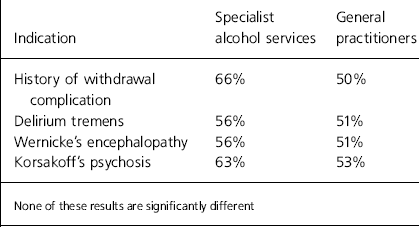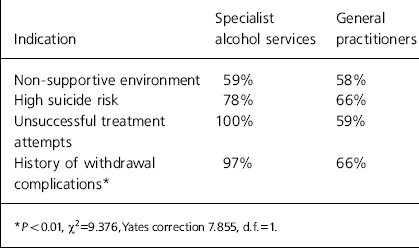Alcohol dependence is a common condition, with the Royal College of General Practitioners estimating that there are at least 300 000 individuals dependent on alcohol in the UK (Royal College of General Practitioners, 1986). This condition is characterised by a withdrawal syndrome that develops after the cessation of, or reduction in, heavy and prolonged alcohol use (American Psychiatric Association, 1994). Pharmacological treatment of this syndrome consists of sedatives that are cross-tolerant with alcohol and vitamins administered in a safe setting. Sedatives are required to prevent the symptoms of uncomplicated alcohol withdrawal, delirium tremens and withdrawal seizures, while vitamins are administered in order to prevent development of Wernicke's encephalopathy. If withdrawal is poorly treated or treated in an inappropriate setting, irreversible complications (for example Korsakoff's psychosis) or death may ensue. While many cases of alcohol withdrawal are managed by general practitioners (GPs), there are, as yet, no data indicating how they manage this condition. We report here how a group of GPs compare with specialist alcohol services (SAS) in the management of alcohol withdrawal.
The study
A questionnaire was designed to study the following aspects during the management of alcohol withdrawal:
-
(a) the type, dose and duration of the sedatives prescribed;
-
(b) the type, dose, duration, route of administration and indications for the use of B vitamins prescribed;
-
(c) the perceived indications for admission to hospital.
The questionnaire was sent to randomly selected GPs in Nottingham (n=147) and all SAS (n=47) as listed in the Alcohol Services Directory. Replies were received from 74 GPs and 32 SAS, response rates of 50.3% and 86% respectively.
Data were analysed using the χ2 and Mann-Whitney U-tests.
Findings
Sedatives
Sixty-one per cent of GPs (n=44) and 91% of SAS (n=29) prescribed a benzodiazepine as the first-line sedative, whereas 18% GPs (n=13) and 3% SAS (n=1) chose to use chlormethiazole. These results demonstrated a significant difference between the two groups (χ2=5.520, Yates correction 4.172, d.f.=1, P<0.05).
Of those practitioners who used benzodiazepines, the initial mean daily dose (in chlordiazepoxide equivalents) used by GPs and SAS were 45.8 mg and 98.1 mg respectively. The dose used by GPs was significantly less than that used by SAS (Mann-Whitney U-test U=136, P<0.001).
Both GPs and SAS used sedatives for an average of nine days.
B vitamins
Only 64% of GPs (n=47) prescribed oral vitamins, compared with 88% of SAS (n=28). GPs were therefore significantly less likely to use such treatment (χ2=5.825, d.f.=1, P<0.05).
The mean daily dose of thiamine prescribed by GPs (16.5 mg) was significantly (Mann-Whitney U-test U=720, Z=-3.2297, P<0.001) less than that prescribed by SAS (77.6 mg).
The mean treatment duration with vitamins for GPs and SAS was 36.2 and 21.5 days respectively, and did not vary significantly between the two groups.
A comparison of the indications for the use of oral vitamins as perceived by GPs and SAS are summarised in Table 1. None of these results demonstrated a significant difference between the two groups of practitioners.
Table 1. Indications for using oral vitamins

| Indication | Specialist alcohol services | General practitioners |
|---|---|---|
| History of withdrawal complication | 66% | 50% |
| Delirium tremens | 56% | 51% |
| Wernicke's encephalopathy | 56% | 51% |
| Korsakoff's psychosis | 63% | 53% |
Parenteral thiamine was prescribed by 11% GPs (n=16) and 13% SAS (n=4). These findings were not significantly different.
Indications for admission
These results are summarised in Table 2. GPs were significantly less likely than SAS to consider a history of withdrawal complications (χ2 9.376, Yates correction 7.855 d.f.=1, P<0.01) as a valid indication for admission.
Table 2. Indications for admission to hospital during alcohol withdrawal

| Indication | Specialist alcohol services | General practitioners |
|---|---|---|
| Non-supportive environment | 59% | 58% |
| High suicide risk | 78% | 66% |
| Unsuccessful treatment attempts | 100% | 59% |
| History of withdrawal complications* | 97% | 66% |
Comment
GPs were significantly more likely to use chlormethiazole as their first-line sedative. This raises concerns, as there are obvious disadvantages in using chlormethiazole, without any clear benefits. For example, although benzodiazepines and chlormethiazole are both equally effective in minimising the symptoms of alcohol withdrawal (Reference Lapierre, Bulmer and OvewumiLapierre et al, 1983), chlormethiazole can lead to physical dependence and can be lethal in overdose, particularly in combination with alcohol (Reference McInnesMcInnes, 1987). The Association of British Pharmaceutical Industry (1995) recommend that chlormethiazole should only be used as a second-line drug where close hospital supervision is available, and for a period not longer than nine days.
GPs were significantly less likely to use oral B vitamins, and if they did so, they used smaller doses than those prescribed by the SAS. This is surprising, particularly as vitamin B deficiencies are prevalent in alcohol-dependent individuals. Furthermore, such deficiencies can lead to serious complications. It is, therefore, important that alcohol-dependent individuals receive early and adequate treatment with B vitamins.
Only a small proportion of both GPs and SAS used parenteral thiamine preparations. It is known that the absorption of oral thiamine in alcohol-dependent individuals is considerably reduced, and therefore patients at high risk of developing Wernicke's encephalopathy may well be best treated with parenteral vitamin therapy. However, such preparations are known to be associated with the occurrence of anaphylactic reactions. It may be for this reason that clinicians have been excessively cautious in their use of such preparations. It would seem sensible to use these preparations in patients who are severely malnourished or unable to take an adequate diet, provided that there are facilities for treating anaphylaxis (Committee on Safety of Medicines, 1989).
GPs were less likely to admit patients with a history of withdrawal complications. This finding is worrying, given that these individuals carry a significant morbidity and mortality when detoxified. There are no nationally agreed guidelines as to which patients should be admitted, however Naik & Brownell (Reference Naik and Brownell1999) recommend that patient groups with high mortality rates (for example those with a history of delirium tremens or withdrawal seizures) should be admitted during subsequent withdrawal.
Our results highlight several areas in the management of alcohol withdrawal by GPs which raise concern. We would, therefore, recommend training for GPs in this common and important area, and suggest that SAS may have a role in such education.





eLetters
No eLetters have been published for this article.